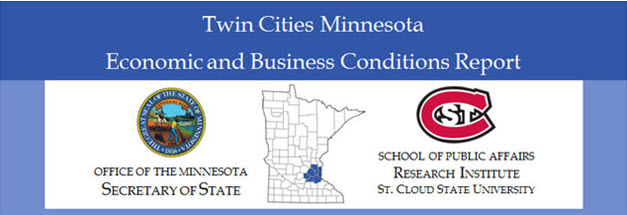Document Type
Research Study
Publication Date
4-2018
Abstract
Despite a fourth quarter decline in the Twin Cities Index of Leading Economic Indicators (LEI), economic growth is expected to remain steady in the Twin Cities over the next several months as overall economic fundamentals remain strong in this part of the state. The Twin Cities LEI registered a -3.07 reading in the fourth quarter. Three of five index components turned down in the fourth quarter, with recent weakness in the Minnesota Business Conditions Index-a general measure of statewide business conditions—and a reduction in the number of residential building permits in the Twin Cities metropolitan area having the largest negative impacts on the LEI. Increased new filings of business incorporation and LLC had a positive effect on the leading index.
There were 10,466 new business filings with the Office of the Minnesota Secretary of State in the seven-county metro area in the fourth quarter of 2017—representing a 12.4 percent increase from one year ago. There were 1,426 new regional business incorporations in the fourth quarter, 7 percent more than year ago levels. Fourth quarter new LLC filings rose to 6,696 in the seven-county metro area—a 15.8 percent increase compared to the fourth quarter of 2016. New assumed names were 6.4 percent higher in the fourth quarter and there were 30 more new non-profit filings in the Twin Cities than one year ago.
Fifty-nine percent of new business filers in the Twin Cities planning area completed the voluntary Minnesota Business Snapshot (MBS) survey in this year’s fourth quarter. Results of this voluntary survey indicate that over 15 percent of new filers come from communities of color. About 5.1 percent of new filings are veterans. A little more than 2 percent of new filers come from the disability community and 9.4 percent of new filings are made by the immigrant community. Thirty-seven percent of new business filings in the Twin Cities planning area in this year’s fourth quarter were initiated by women. MBS results also show that most new business filers in the Twin Cities have between 0 and $10,000 in annual gross revenues (although 651 new filers have revenues in excess of $50,000). The most popular industries for new businesses in the Twin Cities are professional/scientific/technical, retail trade, real estate/rental/leasing, construction, and other services. Employment levels at most new firms are between 0 and 5 workers, and 45 percent of those starting a new business consider this a part-time activity.
Twin Cities planning area employment increased by 3.8 percent over the year ending December 2017. At 2.7 percent, the planning area’s unemployment rate was considerably lower than one year earlier. Initial claims for unemployment insurance were lower than year ago levels, falling by 9.1 percent to 9,873. Due to a statistical anomaly, the region’s average weekly wages fell in the third quarter of 2017 compared to one year earlier. However, average hourly earnings rose for private sector workers in the 16-county Minneapolis-St. Paul MSA over the year ending December 2017, but average weekly work hours were flat. The planning area labor force increased by 3.1 percent over the year ending December 2017. Annual bankruptcies continue to rise in the Twin Cities. The relative cost of living rose in Minneapolis but fell in St. Paul.
Recommended Citation
Banaian, King and MacDonald, Richard A., "Twin Cities Area Economic and Business Conditions Report - Fourth Quarter 2017" (2017). Twin Cities Area Economic and Business Conditions Report. 16. http://repository.stcloudstate.edu/qebcr_tc_mn/16




